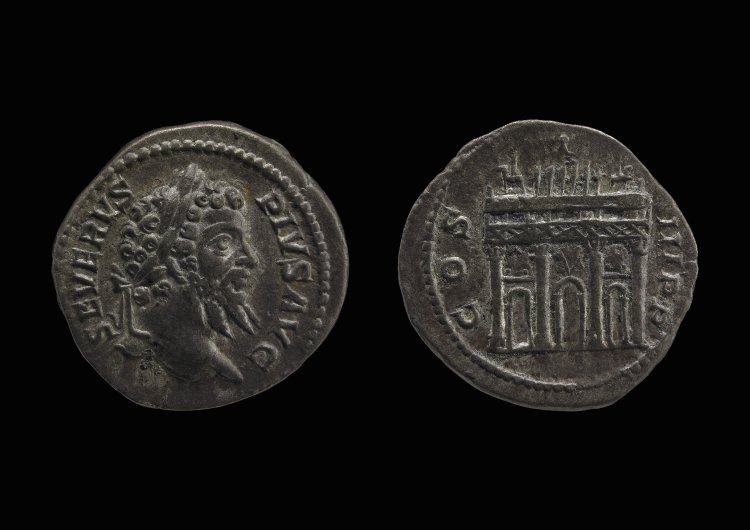Coins
The attic statuary atop the Arch for Septimius Severus, Caracalla, and Geta does not survive and is known to us primarily through numismatic evidence, cuttings/base fragments on the attic, and similar statuary on other imperial arches.1 A coin minted in 204 C.E., the year after the monument was dedicated, shows a six-horse chariot with a rider on each side, and flanking figures that may be trophy bearers or Parthians.2 Though the coin only shows one side of the monument, Popkin notes that the statue cuttings suggest that there was an equestrian statue at each of the four corners.3
One way to view the statues, originally featuring all three dynasts is, as Brilliant explains, as a “framing device for the inscription.” 4 The grand chariot motif (i.e., a chariot with more than four horses), which originated in the early imperial period, recalls the imperial triumph. Popkin suggests that this was meant to highlight Septimius’ martial accomplishments.5
If little is definitely known about the identification statues, even less is known about their creation. Favro tells us that by the last stages of construction the arch would have been surrounded by a high wooden scaffolding, enabling attic statue placement. She also brings up the possibility that the statues were moved through the city in one piece on their way to the arch as a “propagandic act” instead of being assembled piece by piece for easier lifting.6
- Richard Brilliant, The Arch of Septimius Severus in the Roman Forum, Memoirs of the American Academy in Rome 29 (Rome: American Academy in Rome, 1967). Chapter XVI, “Subsequent History of the Arch,” 74.
- Brilliant, 91.
- Maggie Popkin, The Architecture of the Roman Triumph: Monuments, Memory, and Identity (Cambridge: Cambridge University Press, 2016). Chapter 4, “Monuments and Memory Distortion: the Reign of Septimius Severus (AD 193-211),” 147.
- Brilliant, 74.
- Popkin, 147.
- Diane Favro, “Construction Traffic in Imperial Rome: Building the Arch of Septimius Severus,” in Rome, Ostia, Pompeii: Movement and Space, eds Ray Laurence and David J. Newsome (Oxford: Oxford University Press, 2011), 356.
